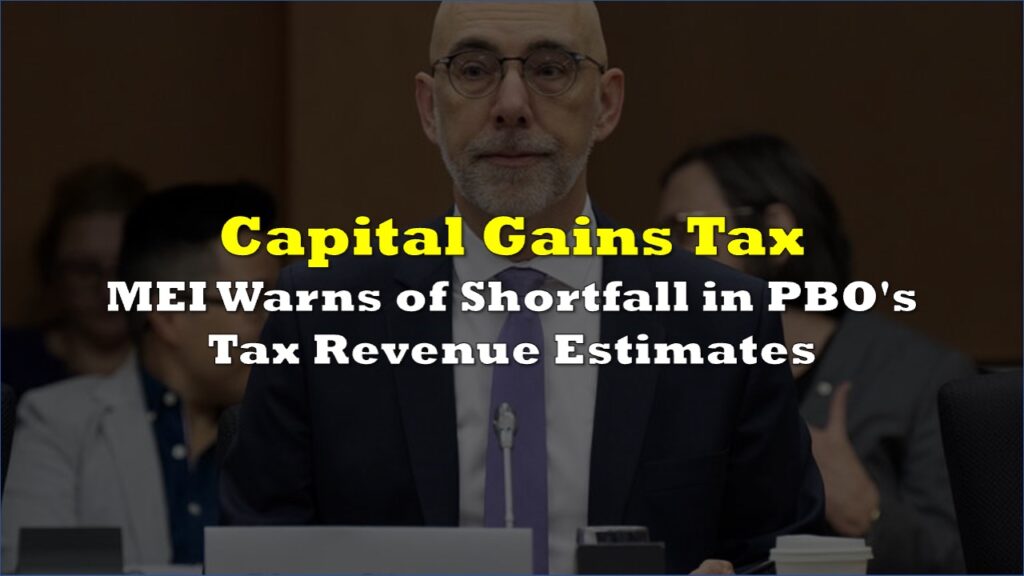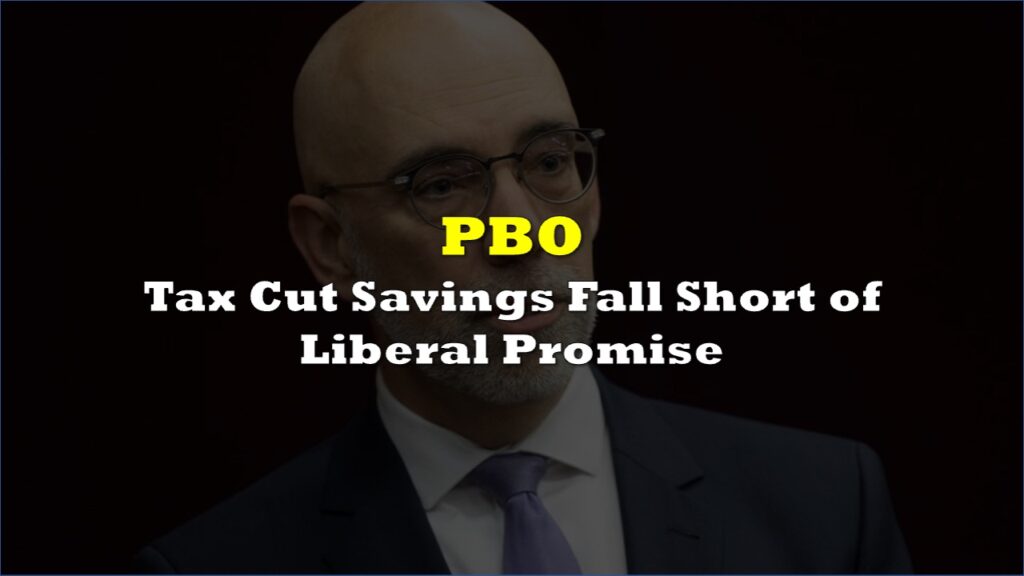The Parliamentary Budget Officer’s report on Budget 2025 warns that federal deficits will average $64.3 billion a year from 2025-26 to 2029-30, more than double the path set out in the 2024 Fall Economic Statement.
The deficit is largely because of $87.0 billion in new day-to-day operating measures, $65.0 billion in higher provisions for liabilities, and $38.7 billion in new capital investment measures.
And here's the BOMBSHELL from today's PBO report.
— Franco Terrazzano (@franco_nomics) November 14, 2025
Carney including too much in capital spending.
And if Carney used proper definition of capital spending, he wouldn't even balance the operating budget.
"Based on PBO’s definition [of capital spending], the day-to-day… pic.twitter.com/vW9CXNAOTl
Starting from the FES 2024 baseline deficits of $42.2 billion in 2025-26, $31.0 billion in 2026-27, $30.4 billion in 2027-28, $27.8 billion in 2028-29, and $23.0 billion in 2029-30, revised direct program expenses alone deepen the shortfall by a cumulative $65.0 billion. Other revisions worth $23.1 billion partially offset these hits, but the budgetary balance before new measures still deteriorates to between $49.2 billion and $38.8 billion a year over the period.
New capital investment measures then add $2.2 billion to the deficit in 2025-26, rising to $10.0 billion in 2027-28 and staying near $9.0 billion a year through 2029-30, for a total of $38.7 billion.
Day-to-day operating measures, which include new ongoing program decisions since FES 2024 and within Budget 2025, further enlarge the shortfall by $26.9 billion in 2025-26, $22.8 billion in 2026-27, $15.6 billion in 2027-28, $10.1 billion in 2028-29, and $11.6 billion in 2029-30, for a cumulative $87.0 billion.
As a result, the overall budgetary balance in Budget 2025 slides to deficits of $78.3 billion in 2025-26, $65.4 billion in 2026-27, $63.5 billion in 2027-28, $57.9 billion in 2028-29 and $56.6 billion in 2029-30, consistent with the reported $64.3 billion annual average.
The watchdog’s sharper critique targets the government’s expanded Capital Budgeting Framework, which classifies not only direct capital formation and amortization but also corporate income tax expenditures, investment tax credits and operating subsidies as capital investments. In the PBO’s view, those tax and subsidy measures represent fiscal costs rather than capital formation under the System of National Accounts or frameworks used in peer jurisdictions such as the UK.
Recasting Budget 2025 tables to include only capital transfers, amortization of federal capital and selected housing measures, the PBO estimates total capital investments of $217.3 billion over 2024-25 to 2029-30, roughly 30% or $94 billion lower than the $311.6 billion reported in the budget. Year by year, Budget 2025 records capital investments rising from $32.2 billion in 2024-25 to about $59.6 billion by 2029-30, while the PBO’s narrower definition yields a much flatter profile from $25.8 billion to $39.0 billion over the same horizon.
BREAKING: Canada’s budget watchdog says of the $311B in planned capital spending from 2024 to 2030, only $217.3B meets the criteria for capital projects — CBC News
— TrendingPolitics.ca (@TrendPolCa) November 14, 2025
I'm gonna be honest, the fact that nobody in the Conservative party noticed this until the PBO report is astonishing.
— Millennial Moron (@Mill_Moron) November 15, 2025
Calculating the baseline "operating balance" from the info in Budget 2025 and FES 2024 was not complicated. https://t.co/EUOrRZpO2P
On this adjusted basis, the operating side looks materially weaker. Using the PBO’s capital definition, the day-to-day operating balance in Budget 2025 is in deficit every year, moving from $10.5 billion in 2024-25 to $45.8 billion in 2025-26, $25.3 billion in 2026-27, $23.3 billion in 2027-28, $18.1 billion in 2028-29 and $17.6 billion in 2029-30.
Finance Canada now projects the federal debt-to-GDP ratio to rise from 41.2% in 2024-25 to slightly above 43% across 2026-27 to 2029-30. Using its stress-testing framework based on historical economic and fiscal shocks, the PBO estimates only a 35.4% chance that the federal debt ratio in 2029-30 will be lower than its 2024-25 level. Confidence intervals prepared by the office show more than half of simulated debt paths above the Budget 2025 projection in every year.
For the deficit-to-GDP anchor, Finance Canada forecasts the ratio to climb to 2.5% in 2025-26 and then fall to 1.5% by 2029-30. PBO simulations suggest only a 7.5% probability that the deficit-to-GDP ratio will decline in every year between 2026-27 and 2029-30.
Today’s scathing report from the Parliamentary Budget Officer:
— Andy Lee (@RealAndyLeeShow) November 14, 2025
“Finance Canada projects the GDP ratio to increase to 2.5% in 2025-26, before declining to reach 1.5% in 2029-30.
Based on PBO stress testing, there is a 7.5% chance that the deficit-to-GDP ratio will decline…” pic.twitter.com/f8VKBwOtV5
Despite these near- and medium-term concerns, the long-term baseline in Budget 2025 yields a debt-to-GDP profile that remains broadly stable over three decades. Finance Canada projects the ratio to rise to 43.6% in 2033-34 before easing to 37.2% in 2055-56, only modestly below its initial 41.2% level in 2024-25.
Within this constrained envelope, the Comprehensive Expenditure Review is expected to deliver savings, reflected in the capital table as negative CER adjustments of $0.5 billion in 2027-28, $0.6 billion in 2028-29, and $0.7 billion in 2029-30. However, the PBO notes that Budget 2025 provides only high-level descriptions of three review themes and departmental totals by theme, with no program-level breakdowns of planned cuts, staffing reductions or expected impacts on service delivery.
Defence spending is another area where the PBO highlights informational gaps. Budget 2025 announces $81.8 billion in defence funding over five years on a cash basis, including more than $9 billion already appropriated for 2025-26. Yet the budget does not clarify how much of this envelope is incremental to projections set out in the 2024 policy document “Our North, Strong and Free” or in the Department of National Defence’s 2025-26 Departmental Plan, nor does it map a path to the government’s stated goal of lifting total defence-related spending to 5% of GDP under the revised NATO framework.
The Government asserts that current federal, provincial, territorial, and municipal plans will provide the 1.5%-point share attributed to broader security and resilience, but offers no supporting estimates, prompting the PBO to seek clarification from DND.
The report also flags growing delays in tabling the audited Public Accounts as a structural risk to fiscal transparency. The 2024-25 Public Accounts reached Parliament more than seven months after year-end, following a 2023-24 release that was almost nine months late. Although the Financial Administration Act currently permits publication as late as the end of December following the close of the fiscal year, the PBO reiterates its recommendation to move the deadline to no later than September 30 so that audited results are available in time.
Information for this story was found via the sources and companies mentioned. The author has no securities or affiliations related to the organizations discussed. Not a recommendation to buy or sell. Always do additional research and consult a professional before purchasing a security. The author holds no licenses.









